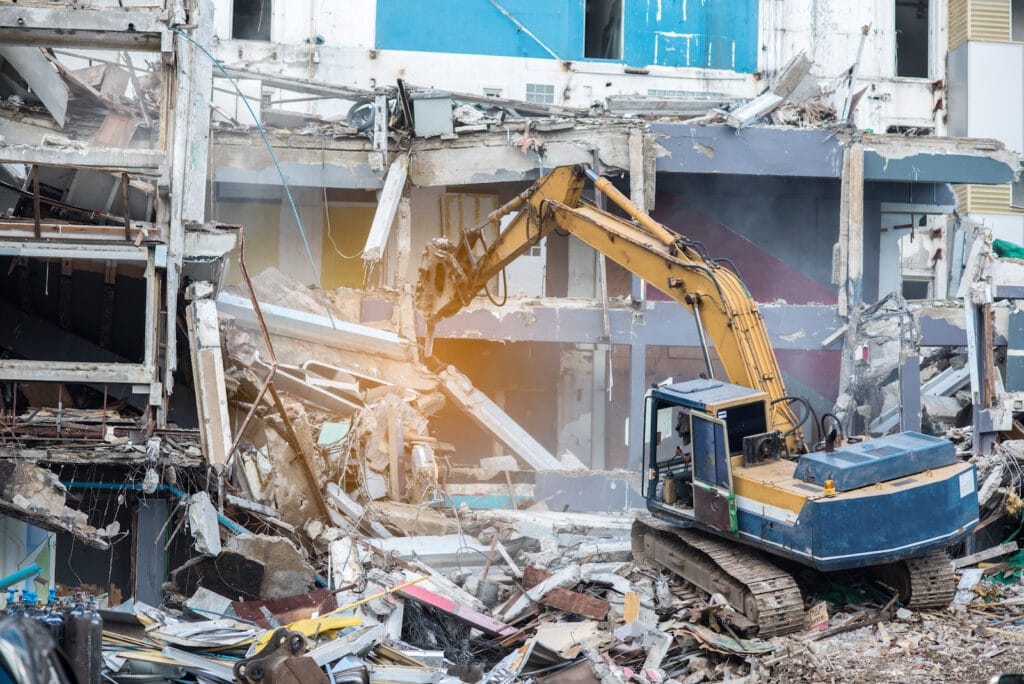We like to think of controlled demolitions as exhibiting something like exquisite chaos. It is controlled chaos, creative destruction, architectured dismantling, and a great way to spend an afternoon. We think so anyway. And we’re not the only ones. Plenty of beautiful and not-so-beautiful buildings have had to come down in the past. After all, we have to go out with the old to come in with the new. So what about all those magnificent structures that have seen their fate be sealed by powerful explosives strapped to their skeletons?
We review some of the most famous demolitions in history and why demolitions say a little bit about how our societies change.
Famous Structures Demolished in the Past Decades
Some buildings take with them their legacy, while others disappear without a trace. In the end, nothing lasts forever. Every building requires its own delicate blueprint for destruction. Here is a list of some of the most recognized demolitions.
Seattle’s Kingdome
Seattle’s Kingdome. Although it was the home to the Seattle Mariners baseball team for 22 seasons, not many fans were particularly in love with this particular stadium. It seems that the Kingdome stadium was not a fan favorite, especially when a tile fell from above and forced the team to have to find another stadium. This large concrete Kingdome was rather bland and not particularly appealing that even the team itself lobbied in the 1990s for a new stadium. The roof was 250 feet high and dangling below were a few speakers that were consistently hit by home runs and long balls. After a relatively short run, this stadium was kindly removed by a massive controlled demolition that caused its implosion and ultimate demise.
Not so good news for the taxpayers, they still owed a large part of the stadium by the time it was demolished about thirty years after its initial construction. When it was blown up, this concrete structure held the local taxpayer with $80 million in debt. Well, at least the residents of the county had a pretty awesome spectacle to view before they went back to paying the bill.
The demolition took 5,800 gelatin dynamite charge explosions. The demolition cord was about 21 miles long and in less than 20 seconds, the 25,000-ton roof collapsed into a rolling dust cloud that vanished the ballpark. Check out the awesome demolition here. The smoke cloud extends wide into the city and the newscasters seem just as taken aback by the spectacle as the local residents.
Yankee Stadium in New York
Another gargantuan undertaking was the old Yankee Stadium or affectionately known as the “Cathedral of Baseball” by many diehards. The stadium was synonymous with the legacy and incredible story of baseball legend Babe Ruth. It was on the Spring day of April 18, 1923, that the baseball hero hit his first home run. It was also the same day that the park had been inaugurated. That same year, Ruth would lead the team to victory in the World Series.
The stadium was a 60,000 seat and $2.5 million dollar investment by a few developers that were convinced that building a ballpark in the Bronx was worth it. It was in September of 2008 that the stadium was retired and ultimately demolished. Many residents of the Bronx still remember the old Yankee Stadium with a considerable amount of nostalgia, but the “House that Ruth built” returned to dust.
Wembley Stadium
In 2003, if we went across the pond, the demolition of one of sport’s most famous stadiums was underway. Recognized as one of the most famous stadiums ever built, Wembley stadium saw its fair share of important games. It hosted the Olympics in 1948 and the 1966 World Cup Final. When it was demolished in the early 2000s, crews salvaged pieces from the wreckage and spread it across London as a symbolic gesture to the legendary ballpark. Known as the “Home of Football,” Wembley Stadium was a central part of the culture in London and was part of the city’s list of historic buildings.
The Metrodome in Minneapolis
Another relic of baseball was the Metrodome in Minneapolis. More specifically known as the Hubert Humphrey Metrodome. This was another large structure that didn’t get a lot of love because of its less-than-popular design and lack of amenities. Many fans complained that the difficulties of spotting a white baseball fly through a white background made it exceedingly difficult to stay focused. This stadium was torn down bit by bit.
The Insight of the Demolition Game
Although we specialize in the deconstruction of structures, their architecture and beauty do not get lost on us. These buildings become part of the communities in which they stand. They form part of childhood experiences and the shared spaces that people live with.
These spaces represent our love of sport and how athletic glory etches itself into the cultural consciousness. In England, football is part of life and has been so intimately intertwined with the culture that it is part of life.
Learn More with RM Demolition
Every building tells a story. Every structure represents its time in history and grows roots as it becomes ingrained in communities. But eventually, things have to come down. And that’s why we’re here. Controlled demolitions must be done with care and precision.
Learn more about controlled demolitions in El Paso with RM Demolition. Call us today.

